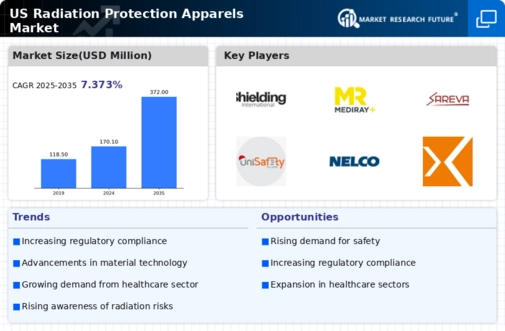Expansion of Nuclear Industry
The expansion of the nuclear industry in the United States significantly impacts the radiation protection-apparels market. As new nuclear power plants are developed and existing facilities undergo upgrades, the need for protective clothing for workers in these environments becomes increasingly critical. The nuclear sector is projected to contribute approximately $90 billion to the economy by 2030, necessitating stringent safety measures, including the use of specialized radiation protection apparel. Workers in nuclear facilities face potential exposure to harmful radiation, making the availability of high-quality protective gear essential. This demand is likely to drive innovation in the market, as manufacturers strive to create apparel that meets the rigorous safety standards required in the nuclear industry. Consequently, the growth of this sector is expected to have a direct and positive effect on the radiation protection-apparels market.
Increased Regulatory Scrutiny
Increased regulatory scrutiny surrounding radiation safety is a key driver for the radiation protection-apparels market. Regulatory bodies, such as the Nuclear Regulatory Commission (NRC) and the Occupational Safety and Health Administration (OSHA), enforce strict guidelines regarding radiation exposure limits for workers. Compliance with these regulations necessitates the use of appropriate protective apparel, thereby fueling market growth. Companies are compelled to invest in high-quality radiation protection clothing to ensure compliance and safeguard their employees. The market is expected to see a surge in demand as organizations prioritize adherence to safety regulations. Furthermore, the potential for penalties and legal repercussions for non-compliance may drive companies to seek out advanced protective solutions, further enhancing the market's expansion. This regulatory environment creates a robust framework for the radiation protection-apparels market to thrive.
Growing Demand in Healthcare Sector
The healthcare sector's increasing focus on patient and staff safety drives the radiation protection-apparels market. Hospitals and clinics are investing in advanced protective clothing to shield against radiation exposure during diagnostic and therapeutic procedures. The market is projected to grow at a CAGR of approximately 6.5% from 2025 to 2030, reflecting the rising need for protective gear in medical environments. This trend is particularly evident in radiology departments, where the use of lead aprons and other protective garments is becoming standard practice. As healthcare facilities prioritize safety, the demand for high-quality radiation protection apparel is expected to rise, thereby bolstering the market's growth. Furthermore, the integration of innovative materials that enhance comfort and mobility while providing adequate protection is likely to attract more healthcare providers to invest in these products.
Technological Innovations in Fabrication
Technological innovations in the fabrication of radiation protection apparel are transforming the market landscape. Advances in material science have led to the development of lighter, more flexible, and effective protective garments. These innovations not only enhance comfort for the wearer but also improve the overall efficacy of radiation shielding. The introduction of new materials, such as lead-free composites and advanced polymers, is likely to attract a broader customer base, including those who may have previously avoided heavy lead-based apparel. As manufacturers continue to invest in research and development, the radiation protection-apparels market is poised for growth. The ability to offer products that combine safety with comfort and mobility is expected to resonate well with end-users, particularly in sectors such as healthcare and nuclear energy, where prolonged wear is common.
Rising Public Awareness of Radiation Risks
Rising public awareness of radiation risks is a significant driver for the radiation protection-apparels market. As information about the potential dangers of radiation exposure becomes more accessible, individuals and organizations are increasingly prioritizing safety measures. This heightened awareness is particularly evident in sectors such as healthcare, where patients and staff are more informed about the risks associated with diagnostic imaging and radiation therapy. Consequently, healthcare providers are compelled to invest in high-quality radiation protection apparel to ensure the safety of their personnel and patients. The market is likely to benefit from this trend, as more institutions recognize the importance of protective clothing in mitigating radiation exposure. Additionally, educational campaigns and training programs aimed at increasing awareness of radiation safety are expected to further drive demand for protective apparel, solidifying its role in safeguarding health.

















Leave a Comment